If you enjoy watching birds or want to attract more feathered friends, learning about common backyard birds in Arkansas is a great place to start. The state offers a rich variety of colorful and lively species that brighten gardens and neighborhoods throughout the year. This guide covers 30 popular backyard birds with clear pictures and identification tips to help you recognize them easily.
From the bright red Northern Cardinal to the energetic Carolina Chickadee, these backyard birds in Arkansas showcase unique colors, songs, and behaviors. Detailed descriptions and photos make it simple to identify each species and understand their feeding habits and preferred environments.
Knowing the birds that visit your yard can deepen your connection to nature and enhance your outdoor experience. With this list of backyard birds in Arkansas, you’ll gain valuable insights into their seasonal patterns and habits, making your backyard a welcoming sanctuary for wildlife.
Common Backyard Birds Found in Arkansas
Tufted Titmouse
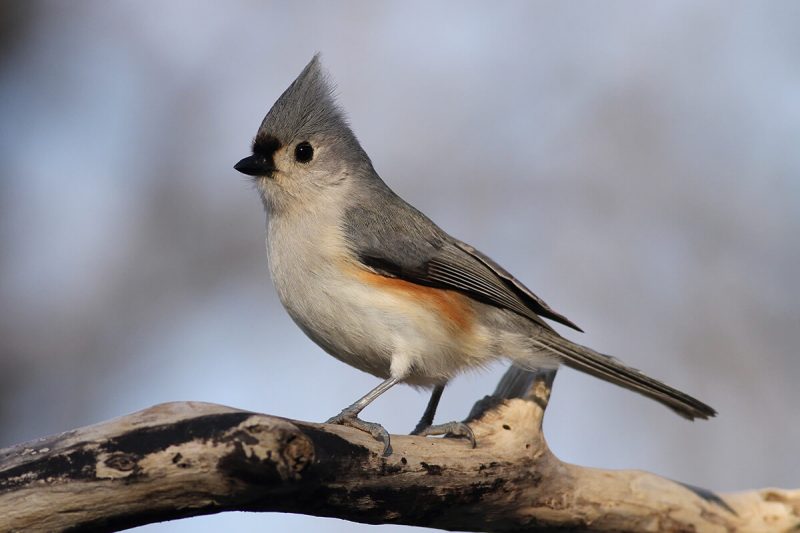
The Tufted Titmouse is a small, active bird with a distinctive gray crest and large black eyes that give it a curious, expressive look. Its upperparts are soft gray, and the underparts are pale with a subtle wash of rust on the flanks. The bird’s song is a loud, whistled “peter-peter-peter,” which is often heard in Arkansas backyards.
This species is closely associated with deciduous forests but is equally at home in suburban areas with plenty of trees. Tufted Titmice often travel in small groups and are commonly seen with chickadees and nuthatches. They move quickly from branch to branch and are frequent visitors to backyard feeders.
Their diet includes seeds, nuts, berries, and a wide range of insects, particularly caterpillars and beetles. At feeders, they enjoy sunflower seeds, peanuts, and suet. They nest in tree cavities or nest boxes and often line their nests with soft animal hair. Tufted Titmice are permanent residents across Arkansas.
Northern Cardinal
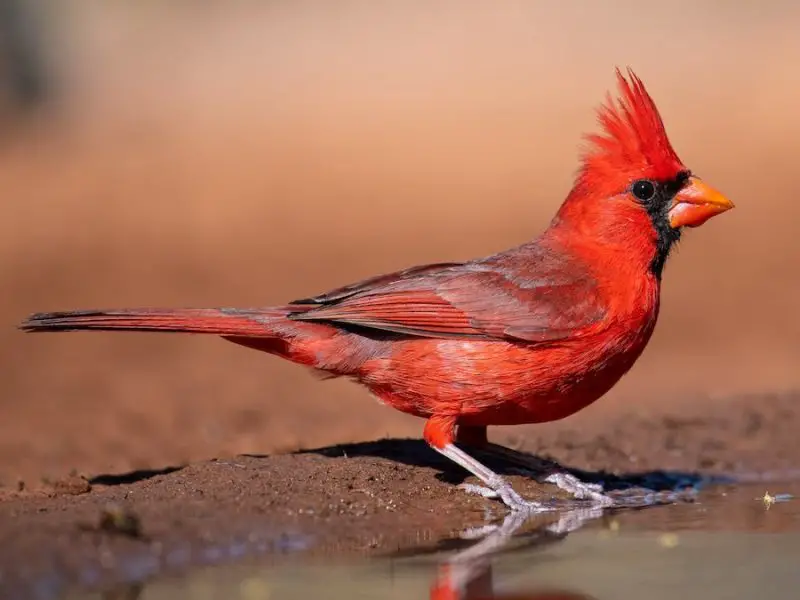
The Northern Cardinal is one of the most recognizable and beloved backyard birds in Arkansas. Males are vibrant red with a black mask around their beak, while females are a soft, warm brown with hints of red on the wings, crest, and tail. Both sexes have a distinctive crest on their head and a thick, orange-red bill that helps with seed cracking.
Northern Cardinals are non-migratory and remain in Arkansas year-round, making them a familiar sight throughout all seasons. They are most commonly seen in suburban backyards, woodlands, thickets, and forest edges. These birds are often among the first to visit feeders in the morning and the last before sunset.
Their diet primarily consists of seeds, particularly sunflower seeds, which they crack open with ease. They also eat fruits and insects, especially during breeding season to feed their young. Cardinals build cup-shaped nests in dense shrubs or small trees, and their sweet, whistled songs add music to many Arkansas neighborhoods.
Carolina Chickadee
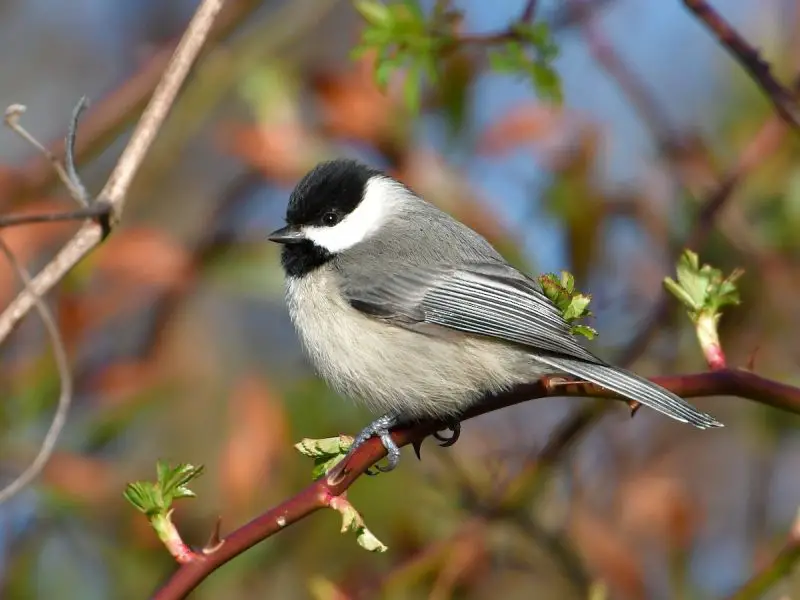
The Carolina Chickadee is a small, agile songbird found across much of Arkansas, especially in wooded residential areas. It has a black cap and bib, bright white cheeks, and soft gray upperparts. The underparts are whitish with a slightly buffy color along the flanks, giving this bird a clean, crisp appearance.
Carolina Chickadees are highly social and frequently join mixed-species flocks during the non-breeding season. They are curious and bold for their size, often approaching feeders and people without hesitation. They can be seen flitting through tree branches or hanging upside down as they forage.
These birds feed on a variety of insects, seeds, and berries. At feeders, they particularly enjoy black oil sunflower seeds and suet. Their small nests are often built in natural cavities or nest boxes, especially in suburban yards or mature woodlands. The Carolina Chickadee is a year-round resident throughout Arkansas.
Eastern Bluebird
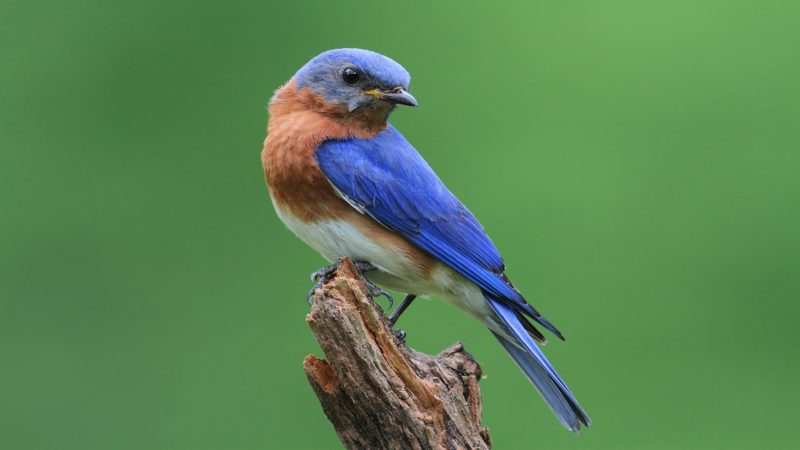
Eastern Bluebirds are strikingly beautiful birds, with males displaying bright royal blue upperparts and a rusty-red throat and chest. Females are more subdued, with grayer blue wings and a paler reddish breast. Their gentle, musical calls are a common sound in open country across Arkansas.
These birds prefer open spaces such as pastures, meadows, and fields, often with scattered trees or fences for perching. They are cavity-nesting birds and readily accept nest boxes, making them a favorite among bird enthusiasts who manage bluebird trails or maintain backyard boxes.
Eastern Bluebirds feed primarily on insects such as beetles, grasshoppers, and caterpillars during the warmer months. In colder seasons, they switch to berries and fruits. Though some may migrate south in the winter, many remain year-round in Arkansas, particularly in milder southern regions of the state.
American Goldfinch
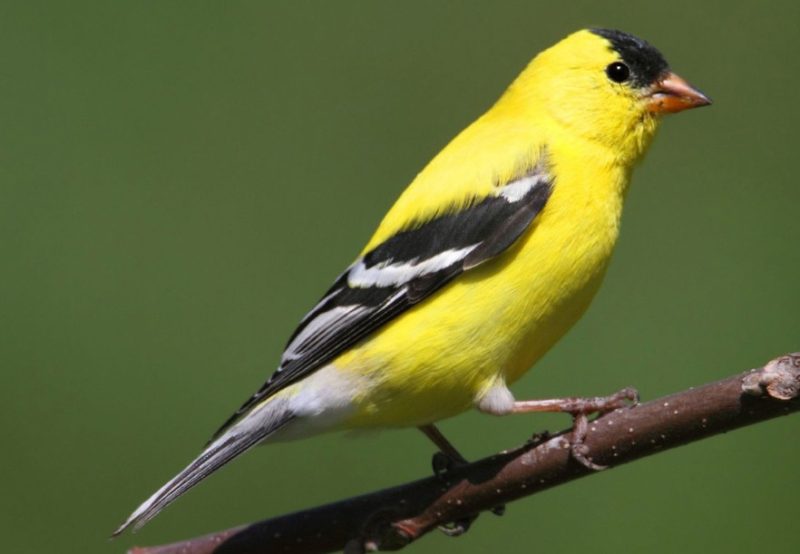
The American Goldfinch is a small, vibrant bird that undergoes dramatic seasonal color changes. In summer, males sport brilliant yellow feathers with black wings and caps, while females wear a more muted olive-yellow plumage. In winter, both sexes molt into duller, brownish tones but retain their black wings and white wing bars.
Goldfinches are late breeders, often waiting until mid to late summer when thistle and sunflower seeds are abundant. They are active and acrobatic, often seen flitting between feeders and plants, and their high-pitched “po-ta-to-chip” flight call is a familiar sound across Arkansas neighborhoods and fields.
Their primary diet is made up of seeds, especially from thistles, dandelions, sunflowers, and other weedy plants. At feeders, they prefer nyjer (thistle seed) and sunflower chips. Goldfinches are widespread throughout Arkansas and tend to gather in flocks during migration and winter months, particularly in weedy fields and open suburban areas.
Mourning Dove
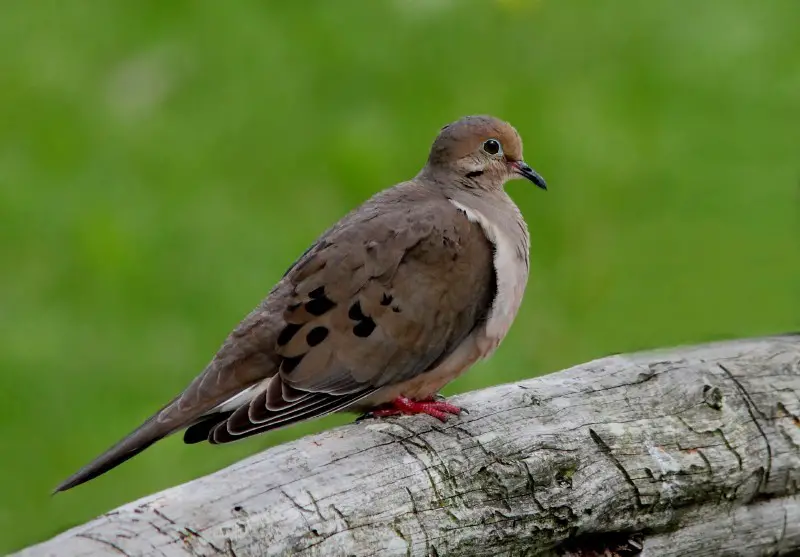
The Mourning Dove is a slender, graceful bird known for its soft, mournful cooing that echoes gently through neighborhoods and countryside across Arkansas. It has a light brown to grayish body with a slightly pinkish hue on the chest, a small head, and a long, pointed tail edged with white. Black spots on the wings and a subtle iridescence around the neck add to its beauty.
These doves are ground foragers, often seen walking beneath feeders or along driveways and open lawns in search of seeds. They also perch comfortably on telephone wires, fence posts, or tree limbs, resting with their heads tucked into their feathers. Mourning Doves are gentle and shy, often fluttering away quickly when startled.
Their diet consists almost entirely of seeds, including millet, cracked corn, and sunflower seeds. They are common at tray feeders and will feed directly from the ground. Mourning Doves are year-round residents in Arkansas, nesting in trees or shrubs and sometimes on flat surfaces like beams and balconies near human homes.
Blue Jay

The Blue Jay is one of Arkansas’s most striking backyard birds, with vibrant blue upperparts, a white chest, and a bold black necklace. Its prominent crest and intelligent eyes give it a commanding presence. Their loud “jay-jay” calls and wide variety of sounds make them highly noticeable in suburban neighborhoods.
Blue Jays are known for their intelligence and complex social behavior. They are curious, adaptable birds that often travel in noisy family groups. Though they can be aggressive at feeders, they also act as early warning sentinels, alerting other birds of potential predators with their loud calls.
Their diet is varied and includes acorns, seeds, nuts, fruits, and insects. They especially enjoy peanuts and sunflower seeds at feeders, often carrying them away to store for later. Blue Jays are common throughout Arkansas and prefer areas with trees, including residential yards, parks, and forest edges.
Red-bellied Woodpecker

Despite its name, the Red-bellied Woodpecker is more easily identified by the red cap and nape seen on males and females, rather than the faint reddish tint on its belly. Its back is boldly patterned in black and white bars, and it has a pale face with a long, sturdy bill suited for drumming on wood.
These woodpeckers are widespread in Arkansas and are frequent visitors to wooded backyards and parks. They often cling to tree trunks or branches, using their strong tails for support, and are known for their loud rolling calls. They also visit feeders, especially those that offer suet or peanuts.
Their natural diet includes insects, nuts, and fruits, which they glean from bark or catch in mid-air. In residential settings, Red-bellied Woodpeckers enjoy suet, sunflower seeds, and cracked corn. They nest in tree cavities and are year-round residents across most of Arkansas, especially in hardwood forests and suburban areas with mature trees.
Downy Woodpecker

The Downy Woodpecker is the smallest woodpecker species in Arkansas and a common sight in backyard trees and at feeders. It has black-and-white plumage with a white back, white underparts, and black wings spotted with white. Males have a small red patch on the back of the head, while females do not.
These agile birds are often seen climbing tree trunks or hanging from twigs and feeder cages. Downy Woodpeckers are known for their gentle tapping sounds as they forage for insects in bark crevices. Their high-pitched “pik” calls and whinny-like trills make them easy to detect even when out of sight.
They feed on insects, larvae, and spiders but also enjoy seeds and suet at feeders. Black oil sunflower seeds are a favorite, as is suet offered in winter. Downy Woodpeckers nest in cavities they excavate in dead trees or limbs and are found statewide in Arkansas, thriving in forests, orchards, and well-treed neighborhoods.
House Finch
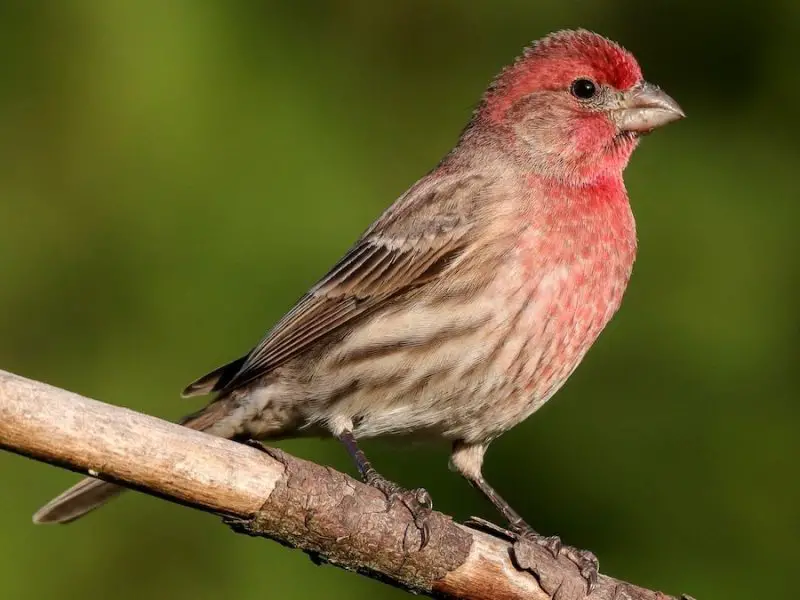
The House Finch is a small, social songbird commonly found at feeders and in residential areas across Arkansas. Males are noted for their rosy red heads, throats, and chests, while females are uniformly brown with streaks across the body. Both sexes have conical bills and slightly notched tails.
These finches often form loose flocks and are highly vocal, filling the air with cheerful, warbling songs. They are adaptable and readily nest on buildings, hanging planters, or in dense shrubs. House Finches are among the most familiar birds in urban and suburban areas.
They primarily eat seeds, grains, and fruits, and are frequent visitors to tube and tray feeders. Sunflower seeds, millet, and thistle seed are among their favorites. House Finches are present in Arkansas throughout the year and thrive in open areas with scattered trees, especially near human habitation.
White-throated Sparrow

The White-throated Sparrow is a striking winter visitor to Arkansas, known for the clean white throat that contrasts with its gray breast and bold black-and-white head stripes. One of its most distinctive features is the bright yellow spot between the eye and the bill, known as the lores. These birds often appear in flocks and are easy to identify with their crisp markings and plump bodies.
They spend much of their time on the ground, scratching through leaf litter or snow in search of seeds and insects. White-throated Sparrows are more active during the cooler months in Arkansas, especially from late fall through early spring, when they migrate down from their breeding grounds in the northern U.S. and Canada. They frequent brushy edges, woodland borders, and well-shaded suburban yards.
Their song is a sweet, whistled “Oh-sweet-Canada-Canada,” which is sometimes heard on mild winter days. At feeders, they enjoy cracked corn, millet, and sunflower chips. These sparrows are often seen hopping under feeders or along garden beds and are welcomed guests for backyard birdwatchers during the colder months.
American Robin
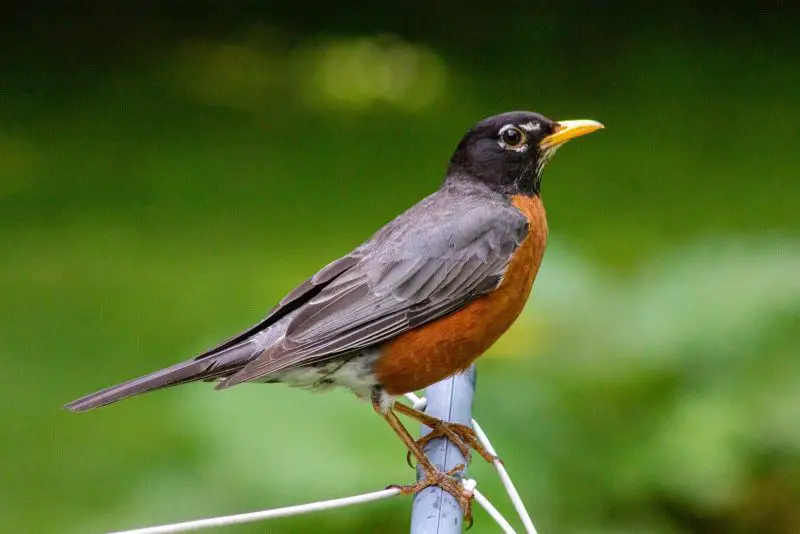
The American Robin is one of the most familiar birds in Arkansas, easily recognized by its brick-red chest, gray-brown back, and white throat streaked with black. Robins have a yellow beak and a dark head, and their upright posture and long legs make them easy to spot as they strut across lawns and fields in search of food.
These birds are active and alert, frequently seen tugging worms from grassy lawns during the day. They are early risers, often heard singing before sunrise with a melodious series of clear whistles. Robins are present year-round in Arkansas but are more noticeable during spring and summer when they’re busy nesting and feeding young.
American Robins build nests in trees, shrubs, or on building ledges, often using mud and grass to form their sturdy cup-shaped homes. While they mainly eat earthworms and insects, they also enjoy fruits like berries, especially in fall and winter. Robins are not common at feeders, but they may visit yards with birdbaths or berry-producing shrubs.
Carolina Wren
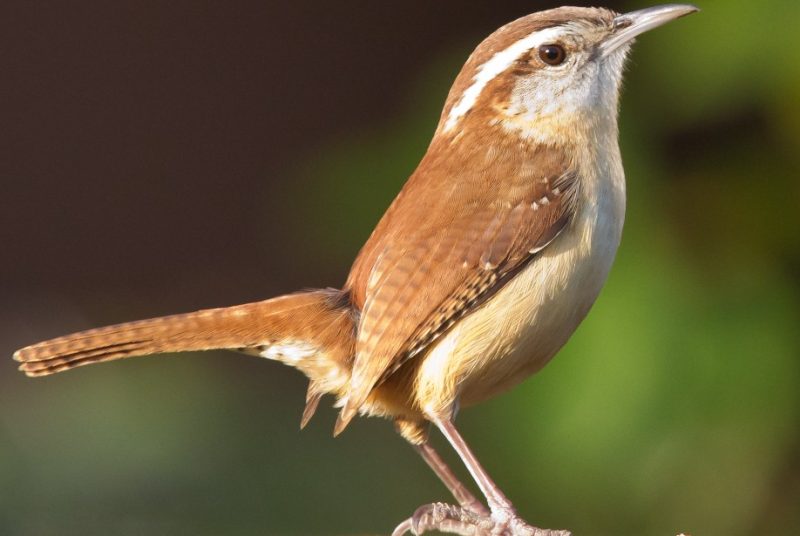
The Carolina Wren is a small, energetic bird with a rich reddish-brown back, buffy underparts, and a prominent white eyebrow stripe. It has a slightly curved bill and a habit of holding its tail cocked upward, giving it a lively appearance. Though small in size, it has an impressively loud and musical voice that echoes through Arkansas neighborhoods year-round.
Carolina Wrens are curious and adaptable, preferring brushy backyards, wood piles, dense shrubbery, or tangled vines. They are often heard before they’re seen, with their repeated “tea-kettle, tea-kettle, tea-kettle” song and sharp calls. Pairs remain together throughout the year and may nest in unusual spots such as mailboxes, flowerpots, or hanging planters.
Their diet includes insects, spiders, and some seeds or berries. They occasionally visit feeders for suet, peanut butter, or mealworms. Carolina Wrens are non-migratory and can be found across all regions of Arkansas, especially where there’s good ground cover and shelter for nesting and foraging.
Northern Mockingbird
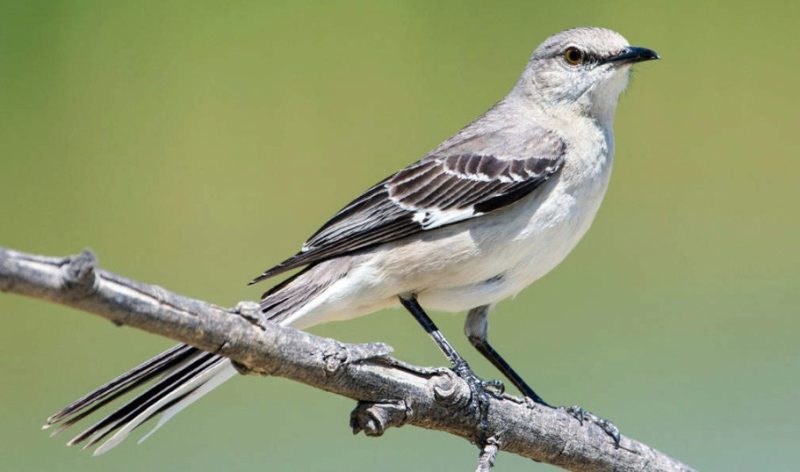
The Northern Mockingbird, Arkansas’s official state bird, is a sleek gray songbird with pale underparts, white wing patches, and long legs and tail. When in flight, its white outer tail feathers and large wing flashes are highly visible, making it easy to identify. It is known not only for its appearance but for its unmatched vocal abilities.
This bird is a talented mimic, often singing long series of phrases that include imitations of other birds, car alarms, and even cell phone rings. Males sing both day and night, especially in spring, and their repetitive musical medleys are a familiar part of Arkansas’s soundscape. They are highly territorial and will defend their space aggressively from intruders, including other birds and cats.
Northern Mockingbirds are commonly seen perched on fences, rooftops, or treetops where they keep watch. They prefer open areas with nearby shrubs or trees and are found in both rural and urban settings. Their diet includes insects, berries, and fruits. While they don’t frequent seed feeders, they may visit yards with berry bushes or mealworms.
Brown Thrasher
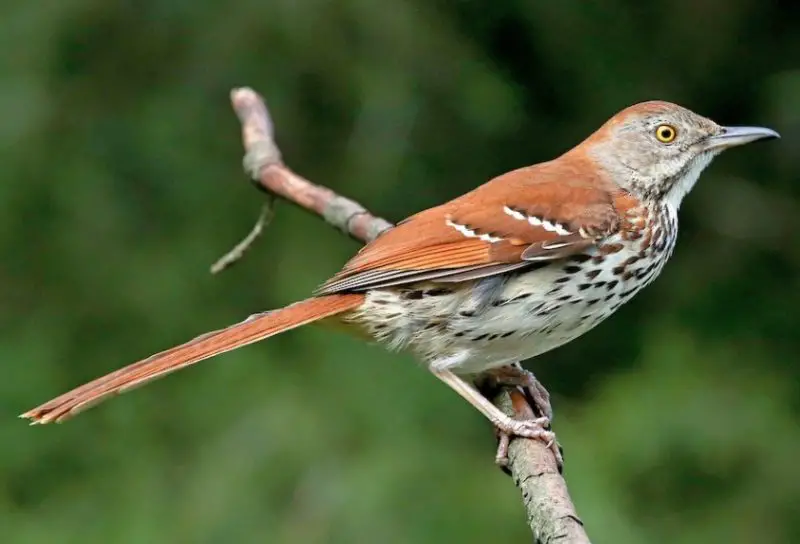
The Brown Thrasher is a medium-sized bird characterized by its warm reddish-brown upperparts and heavily streaked chest. It has bright yellow eyes and a long, slightly curved bill. This bird is often seen foraging on the ground beneath dense shrubs or thickets, flicking leaves aside to uncover insects and seeds.
Brown Thrashers are known for their extensive and varied song repertoire, which can include hundreds of different phrases. They prefer dense brushy habitats where they can stay hidden while singing or feeding. This secretive nature helps them avoid predators while still being an audible presence in Arkansas woodlands and overgrown yards.
Their diet consists mostly of insects, fruits, and seeds. They frequently scratch the leaf litter to find beetles, grasshoppers, and caterpillars. Brown Thrashers nest low in thick shrubs or tangles, often making a bulky cup-shaped nest where the female incubates the eggs. They are year-round residents throughout Arkansas.
Chipping Sparrow
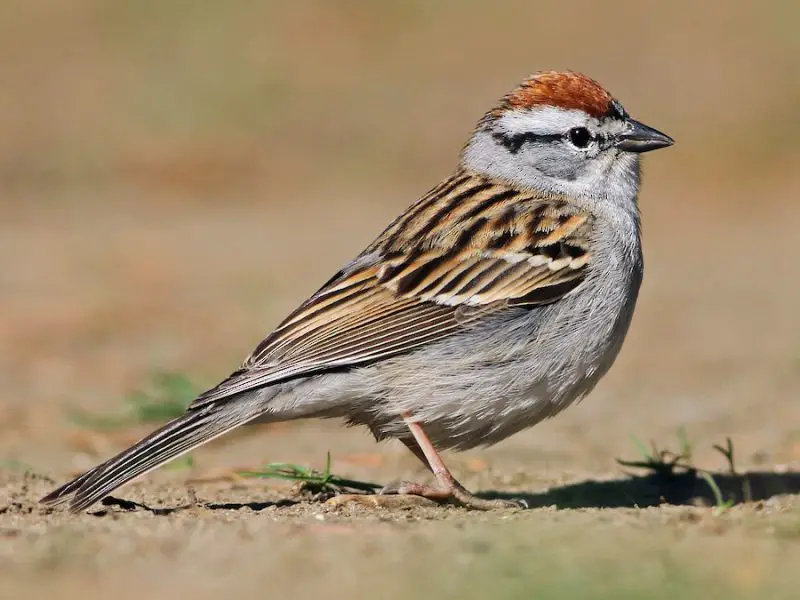
The Chipping Sparrow is a small, slender bird with a clean gray breast and rusty-cinnamon cap. It has a clear black line through the eye, giving it a distinct facial pattern. These sparrows are especially common during spring and summer in Arkansas, often found in open woodlands, parks, and suburban yards.
Chipping Sparrows typically forage on the ground, picking up small seeds and insects. They also readily visit backyard feeders offering small seeds like millet and cracked corn. Their song is a rapid trill that is often heard from treetops or telephone wires.
Nesting usually occurs in low trees or shrubs where they build neat cup-shaped nests. These birds migrate to Arkansas in early spring and are present through summer before heading south in fall. However, some may stay year-round in milder parts of the state.
Pine Warbler
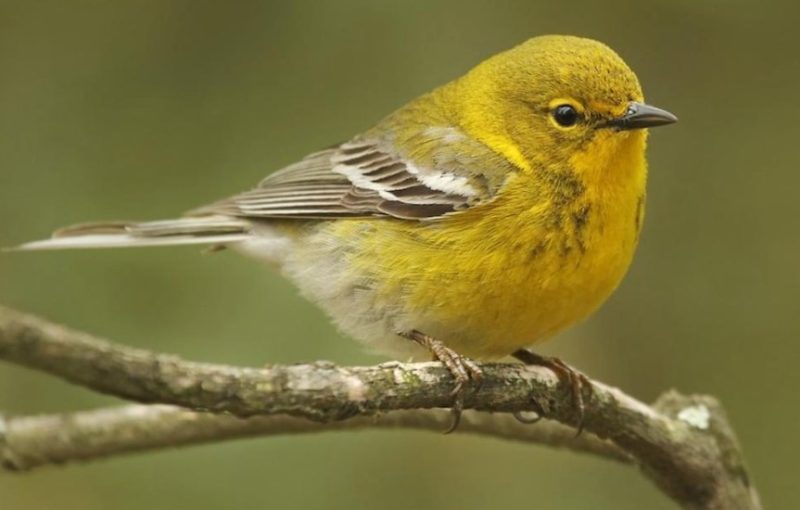
The Pine Warbler is a small songbird with olive-yellow upperparts and bright yellow underparts, making it blend well with pine needles. It has a subtle streaked back and white wing bars. This species is primarily found in pine forests but may visit feeders in Arkansas that offer suet or seeds.
Pine Warblers forage actively in the branches of pine trees, gleaning insects and spiders from needles and bark. They also consume seeds and berries, especially during colder months when insects are scarce. Their song is a musical trill that echoes through pine stands.
While mostly associated with pine forests, Pine Warblers may occasionally visit suburban feeders, especially in areas with mature pines. They are permanent residents in Arkansas, particularly in the southern pine-dominated regions.
Common Grackle
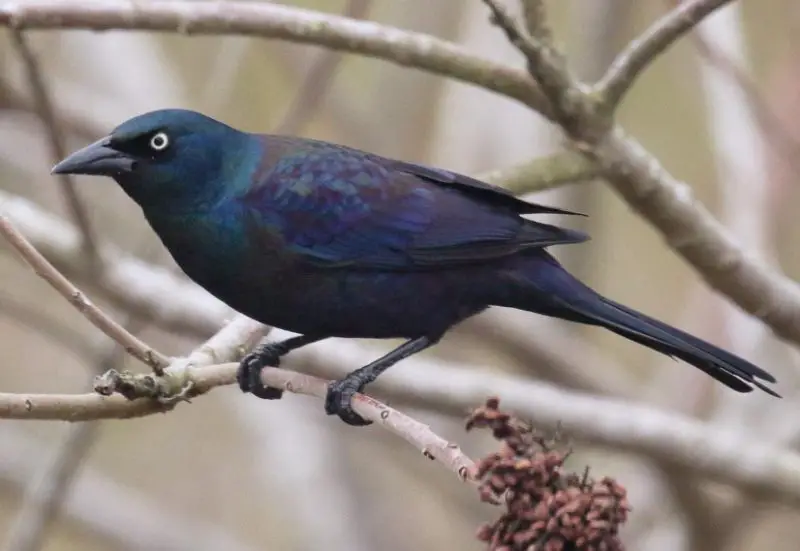
The Common Grackle is a large, striking bird with glossy black plumage that shines iridescent blue, purple, and green in the sunlight. It has a long, wedge-shaped tail and bright yellow eyes that stand out against its dark feathers. These birds often gather in noisy flocks and can create quite a commotion at backyard feeders.
Grackles are highly adaptable and can be found in a wide variety of habitats across Arkansas, including urban parks, farmland, and wetlands. They are opportunistic feeders with a diet that includes insects, seeds, fruits, and even small vertebrates. They frequently forage on the ground and may raid nests for eggs or young birds.
Their loud, harsh calls and gregarious behavior make them very noticeable, especially during migration and winter when they form large flocks. They often dominate feeders, sometimes displacing smaller birds, but also provide interesting birdwatching opportunities.
Brown-headed Cowbird
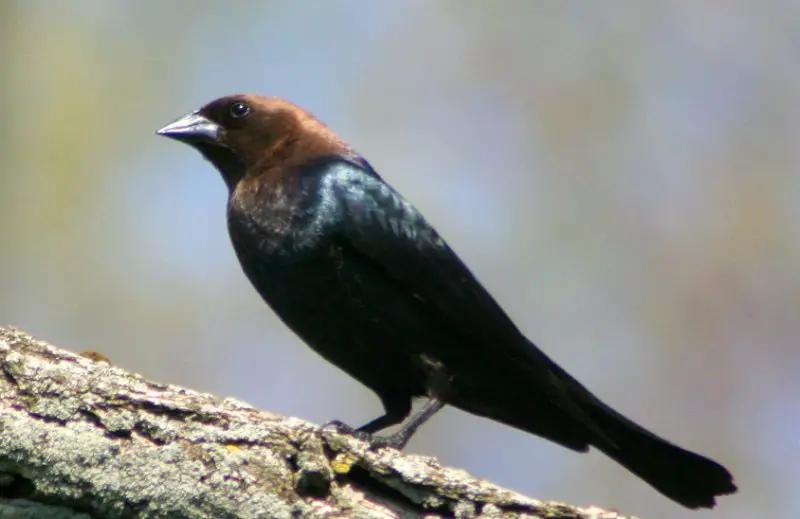
The Brown-headed Cowbird is a brood parasite best known for its unique reproductive strategy of laying eggs in the nests of other bird species. Males have a glossy brown head and shiny black body, while females are mottled brown and gray, providing camouflage.
Cowbirds typically follow grazing animals or farm machinery to catch insects disturbed from the grass. They forage on the ground and in low vegetation, feeding on seeds and insects. These birds are common in open fields, edges, and suburban areas throughout Arkansas.
Because Brown-headed Cowbirds do not build their own nests, they rely on hosts such as sparrows and warblers to raise their young, often at the expense of the host’s offspring. This behavior has made them a subject of interest and concern among ornithologists.
Eastern Towhee
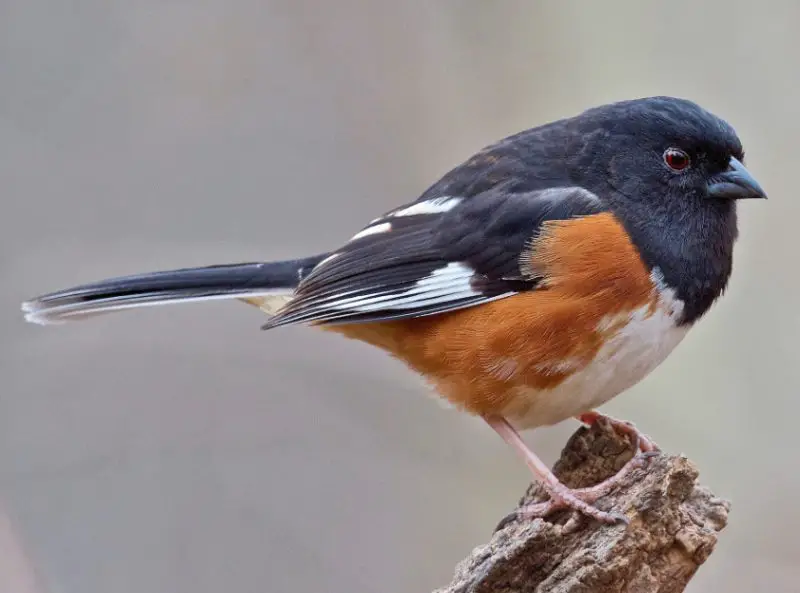
The Eastern Towhee is a striking sparrow with black upperparts and head in males, while females have rich brown in place of black. Both sexes have bright rufous (reddish) flanks and white underparts. They are often found in dense brush and thickets across Arkansas, where they forage on the ground.
These birds use a distinctive “chewink” call that is loud and clear, often heard before the bird is seen. Towhees actively scratch leaf litter with both feet, flipping leaves aside to find insects, seeds, and berries.
Eastern Towhees nest low in dense shrubs or tangles, building cup-shaped nests hidden from predators. They are primarily year-round residents in Arkansas, favoring habitats with thick undergrowth such as woodland edges, overgrown fields, and suburban thickets.
Ruby-throated Hummingbird
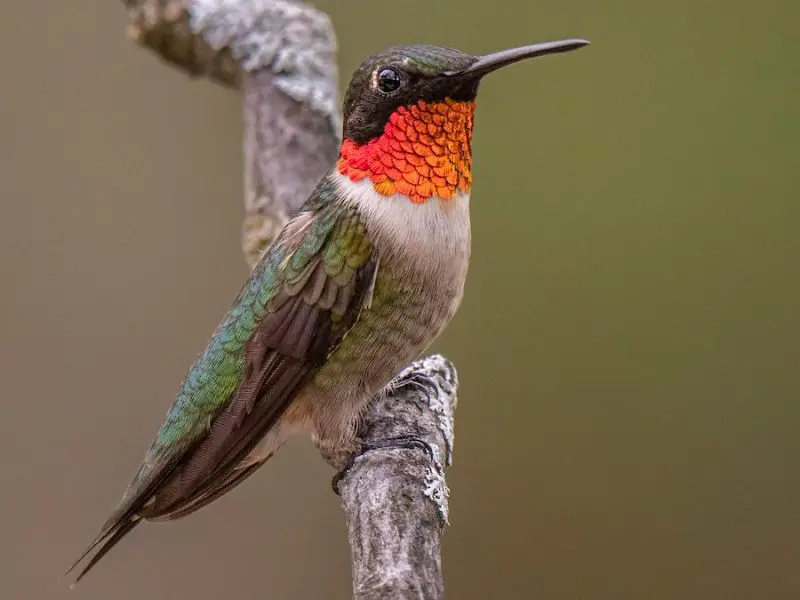
The Ruby-throated Hummingbird is the only species of hummingbird that breeds in Arkansas. Males are easily identified by their shimmering ruby-red throat patch, which gleams brilliantly in sunlight, while females lack the red throat and have a more muted greenish coloration. These tiny birds weigh less than a penny but are incredibly agile flyers, capable of hovering and rapid darting.
Ruby-throated Hummingbirds are attracted to brightly colored, nectar-rich flowers such as trumpet creeper, bee balm, and cardinal flower. They also readily visit hummingbird feeders filled with sugar water, especially during the spring and summer breeding seasons. Their high-pitched buzzing and quick wingbeats make them fascinating to watch in backyards.
During migration, these hummingbirds travel long distances, sometimes crossing the Gulf of Mexico nonstop. In Arkansas, they typically arrive in late April and stay through early fall, nesting in shrubs or small trees. Their diet consists mainly of nectar, but they also consume small insects and spiders for protein.
White-breasted Nuthatch

The White-breasted Nuthatch is a small, stocky bird with a gray back, white face and underparts, and a distinctive black cap. It is well known for its unique behavior of climbing down tree trunks headfirst, using strong feet and a sharp bill to probe bark for insects. This acrobatic movement makes it a favorite among birdwatchers.
These nuthatches are common visitors to backyard feeders in Arkansas, especially those offering suet and black oil sunflower seeds. They often cache food by wedging seeds into tree bark crevices. Their loud, nasal “yank-yank” calls are frequently heard in wooded residential areas and forests.
White-breasted Nuthatches are year-round residents in Arkansas, favoring mature hardwood forests and well-treed suburban neighborhoods. They nest in natural cavities or old woodpecker holes, often enlarging the entrance with mud or bark. Their bold, inquisitive nature makes them frequent feeder guests.
European Starling
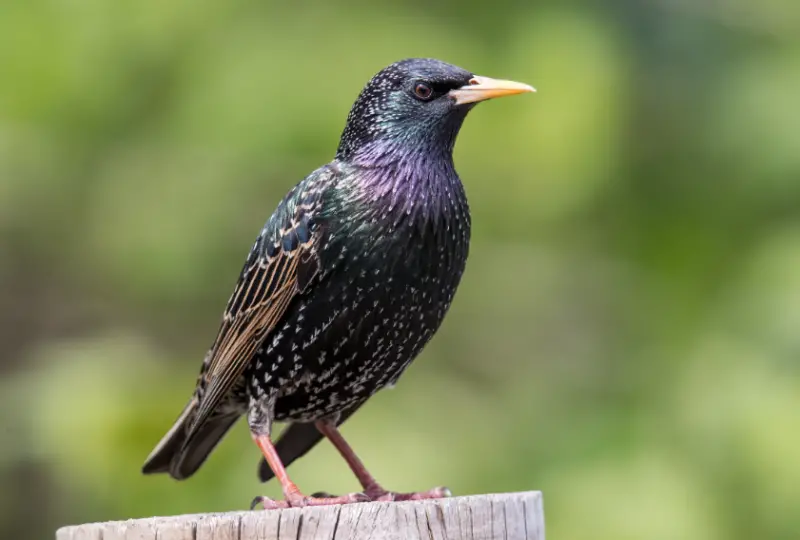
The European Starling is a highly adaptable and abundant invasive species in Arkansas. It has glossy black feathers with iridescent purple and green sheen and is speckled with white spots, especially in winter plumage. These birds are stocky with short tails and pointed bills that change color seasonally.
Known for their remarkable vocal abilities, European Starlings can mimic the songs and calls of many native birds, as well as other sounds like car alarms and human speech. They often form large, noisy flocks, particularly in urban and agricultural areas, creating spectacular murmurations in the sky.
Though considered a pest by many, starlings are opportunistic feeders that eat insects, fruit, seeds, and human food scraps. They nest in cavities, often taking over nest boxes or hollow trees. European Starlings are present year-round across Arkansas and thrive in towns, farms, and open woodlands.
Red-winged Blackbird
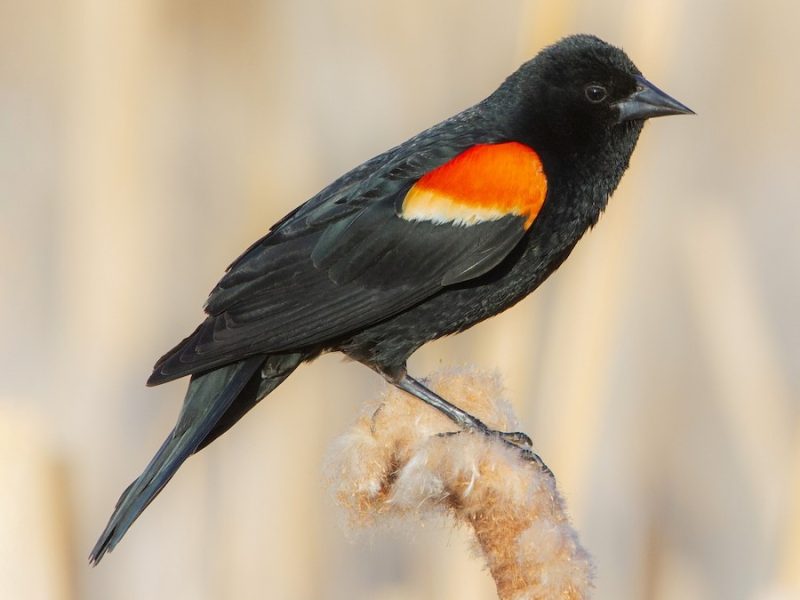
The Red-winged Blackbird is a medium-sized bird best known for the male’s striking red and yellow shoulder patches, which are highly visible during territorial displays. Females are brown and heavily streaked, resembling large sparrows. These birds are widespread across Arkansas, especially near wetlands and marshes.
Males are fiercely territorial during the breeding season and sing a distinctive “conk-la-ree!” call to defend their nesting areas. Red-winged Blackbirds build nests low among cattails, reeds, or shrubs near water but can also be found in agricultural fields and sometimes suburban yards during migration.
Their diet consists of seeds, grains, and insects, and they often forage on the ground or in shallow water. During migration, they can appear in large flocks in open areas and occasionally visit backyard feeders offering cracked corn or sunflower seeds. They are present year-round in much of Arkansas.
House Sparrow
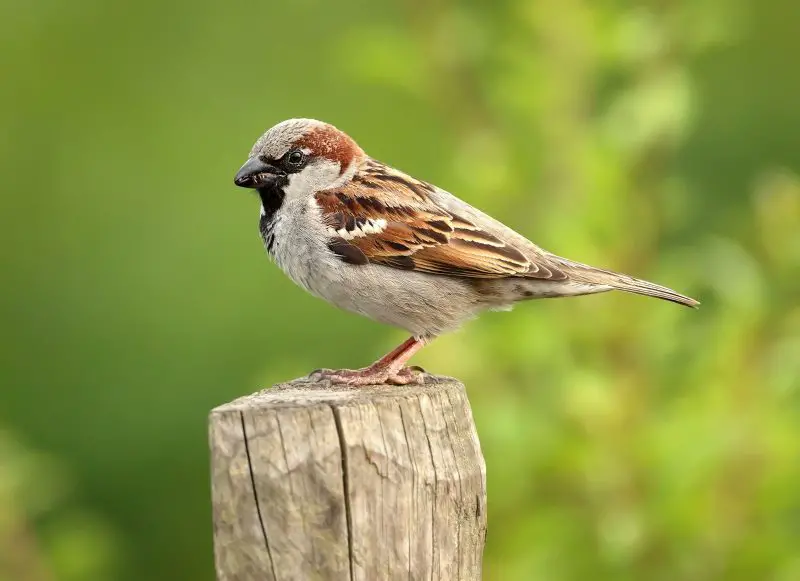
The House Sparrow is a small, highly adaptable bird commonly found around human habitation in Arkansas cities and towns. Males have gray crowns, black bibs, and chestnut markings on the sides of their heads, while females and juveniles are more uniformly brown and streaked, providing camouflage in urban environments.
House Sparrows thrive in urban and suburban areas, often nesting in building crevices, eaves, vents, or nest boxes. They are highly social and noisy birds, frequently seen in flocks scavenging for food scraps around homes, parks, and marketplaces.
Their diet is omnivorous, feeding on grains, seeds, insects, and human food waste. House Sparrows are non-migratory and are present year-round across Arkansas, often competing with native birds for nesting sites and food resources in residential areas.
Cedar Waxwing

The Cedar Waxwing is a sleek bird with a distinctive crest and soft beige-brown plumage. Its face features a striking black mask, bordered by white lines, giving the appearance of a bandit’s mask. The tail is tipped with bright yellow, and the wings often show small red waxy tips, which inspired its name.
These birds are highly social and migrate in flocks across Arkansas, often seen gliding gracefully through open woodlands, orchards, and suburban areas. Cedar Waxwings are known for their fondness for berries and small fruits, frequently feeding on dogwood, serviceberry, and mulberry.
Their diet consists mainly of fruit, but they also consume insects, especially during breeding season. Cedar Waxwings build cup-shaped nests high in trees and are present mostly in spring, summer, and fall in Arkansas before moving south for winter.
Yellow-rumped Warbler
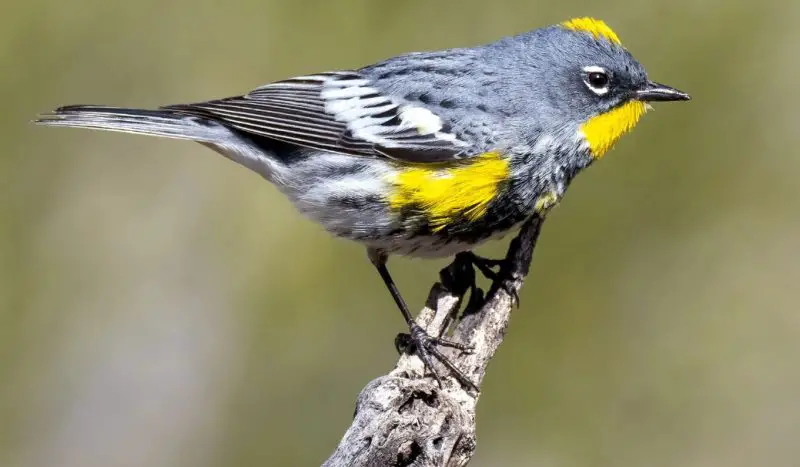
The Yellow-rumped Warbler is a small, energetic songbird easily identified by patches of bright yellow on its lower back, sides, and crown. Its overall plumage is gray with streaks, providing camouflage among trees and shrubs. This species is common in Arkansas during winter and migration periods.
Yellow-rumped Warblers are highly adaptable and can be found in diverse habitats such as forests, parks, and gardens. They are agile foragers, often flicking their wings and hopping along branches while searching for insects, spiders, and berries.
During colder months, they supplement their diet with wax myrtle and bayberry berries, which many other warblers cannot digest. Their fast-paced flight and distinctive buzzy call make them a favorite for birdwatchers in Arkansas’s winter months.
Blue-gray Gnatcatcher
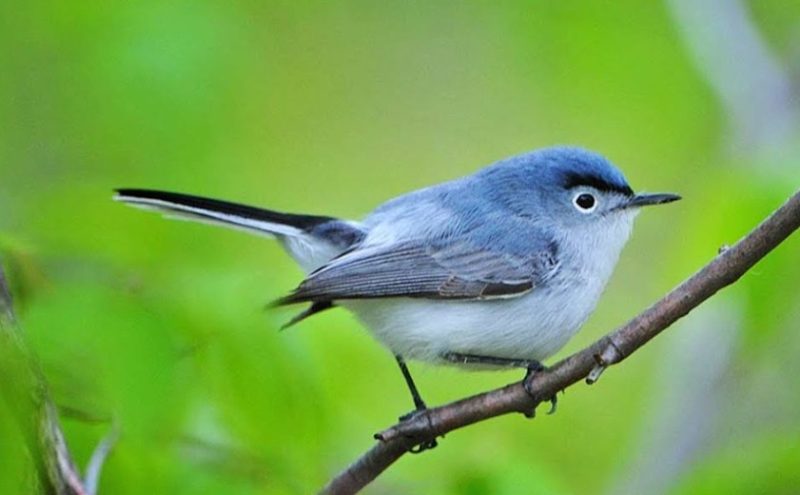
The Blue-gray Gnatcatcher is a tiny, active bird with pale blue-gray plumage and a long, slender tail edged in white. It has a small, thin bill and large dark eyes, giving it an alert expression. This species is frequently seen darting through foliage in Arkansas’s wooded backyards and forests.
Known for its high-pitched, soft “sshhh” call, the Blue-gray Gnatcatcher is an agile insect hunter. It flits rapidly from branch to branch, catching small flying insects and spiders mid-air or gleaning them from leaves and bark.
They build delicate cup-shaped nests often hidden in tree forks or shrubs. These birds are summer residents in Arkansas, arriving in spring to breed before migrating south in fall. Their quick movements and subtle coloring often make them a challenge to spot.
Great Crested Flycatcher

The Great Crested Flycatcher is a large flycatcher distinguished by its shaggy crest, gray-brown upperparts, and bright yellow belly. Its throat and chest are a lighter gray, and it has a broad, sturdy bill designed for catching insects in flight. This bird is commonly found in wooded areas and suburban parks across Arkansas.
As an insectivore, the Great Crested Flycatcher hunts from perches, sallying out to capture flying insects such as beetles, dragonflies, and moths. They also occasionally eat fruits and berries. Their loud, rolling calls are a familiar sound during the breeding season.
These birds nest in natural tree cavities or nest boxes, often lining their nests with feathers and sometimes snakeskin for protection. They are summer residents in Arkansas, arriving in late spring and departing by early fall.
Baltimore Oriole
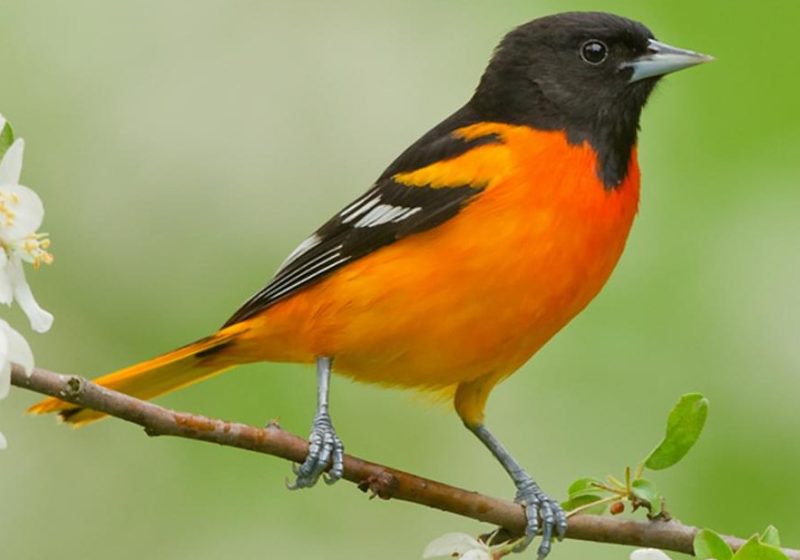
The Baltimore Oriole is a visually stunning bird with brilliant orange plumage contrasted by a glossy black head and back. Males are especially vibrant, while females are more yellow-orange and less intensely marked. These orioles are typically seen in Arkansas during late spring and summer.
Baltimore Orioles prefer open woodlands, forest edges, and suburban yards with tall trees. They are attracted to nectar feeders, fruit, and jelly and are known to feed on insects during the breeding season to provide protein for their young.
Their nests are intricately woven hanging baskets suspended from tree branches. The males’ clear, flute-like whistles and their striking coloration make them a favorite among Arkansas birdwatchers during the warm months.
FAQ about Backyard Birds in Arkansas
What are the most common backyard birds in Arkansas?
Some of the most common backyard birds in Arkansas include Northern Cardinal, Carolina Chickadee, Tufted Titmouse, Eastern Bluebird, American Goldfinch, Mourning Dove, Blue Jay, and many more. These species are regularly spotted at feeders and in wooded residential areas.
When can I see the most backyard birds in Arkansas?
Backyard birds are visible throughout the year in Arkansas. However, spring and summer are peak seasons because of breeding activities, while migration periods in spring and fall bring additional species passing through the state.
What types of food should I offer to attract backyard birds?
To attract a variety of birds, offer sunflower seeds, nyjer (thistle) seeds, suet, peanuts, and fresh fruits like berries. Providing clean water and planting native shrubs and trees also help support bird populations.
How can I create a bird-friendly backyard in Arkansas?
Creating a bird-friendly backyard involves offering diverse food sources, fresh water, safe nesting sites, and shelter through native plants. Minimizing pesticide use and providing natural cover like shrubs or brush piles further encourage birds to visit.
Do backyard birds in Arkansas migrate seasonally?
Yes, many backyard birds migrate through Arkansas or to other regions seasonally. For example, Ruby-throated Hummingbirds and Yellow-rumped Warblers migrate, while species like Northern Cardinals and Carolina Chickadees tend to stay year-round.
Are there any endangered or protected backyard birds in Arkansas?
While most common backyard birds are not endangered, habitat loss can threaten certain species. Supporting local conservation efforts and planting native vegetation helps protect vulnerable bird populations in Arkansas.
What are effective ways to identify backyard birds?
Bird identification is based on features such as size, plumage color, markings, behavior, and bird calls or songs. Using bird identification guides, apps, and online resources focused on Arkansas birds improves accuracy.
How do I prevent squirrels and other pests from disturbing bird feeders?
You can prevent pests by using squirrel-proof feeders, installing baffles on feeder poles, and placing feeders away from jumping points like trees or roofs. Regular feeder maintenance also discourages unwanted visitors.
Can backyard birds damage gardens or crops?
Generally, backyard birds are beneficial as they control insect pests and aid in pollination. Though some may occasionally eat fruits or seeds, their positive effects usually outweigh any minor damage.
Where can I find more information about birds in Arkansas?
For more information, connect with local birdwatching groups, state wildlife agencies, nature centers, and online birding communities. Participating in citizen science projects can also provide valuable learning opportunities.


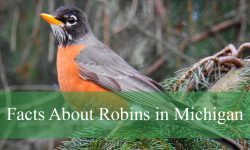

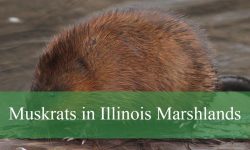
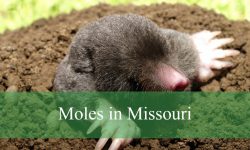

Very informative! I am a “birder” and I have all 30 species you’ve shown at my feeders.